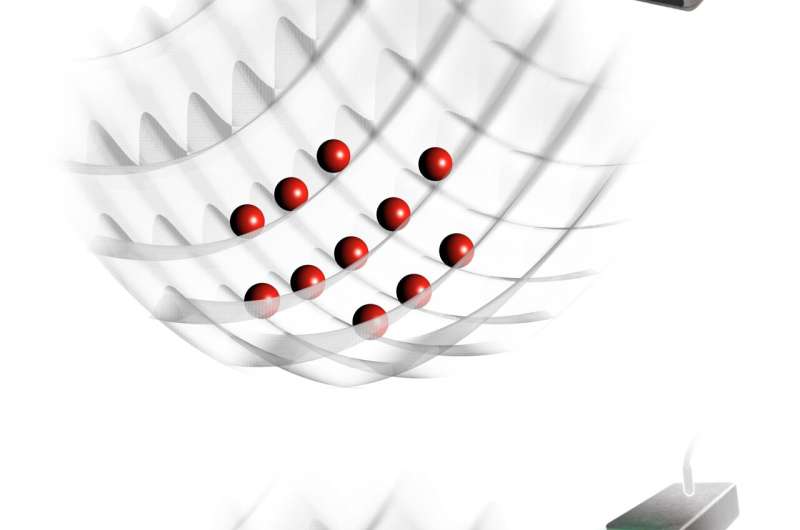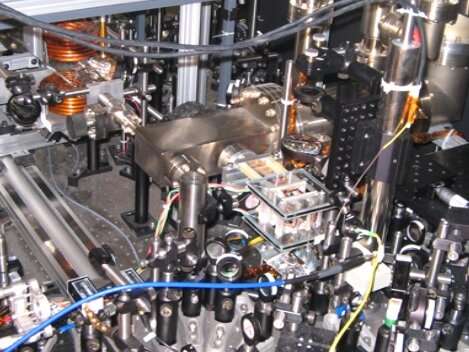April 21, 2022 feature
Study introduces loss-free matter-wave polaritons in an optical lattice system

Polaritons are quasiparticles that are formed when photons couple strongly with excitations of matter. These quasi-particles, which are half-light and half-matter, underpin the functioning of a wide range of emergent photonic quantum systems, including semiconductor-based nanophotonic devices and circuit quantum electrodynamic systems.
Researchers at Stony Brook University have recently introduced a novel polariton system in which the matter excitation is replaced by an atom in an optical lattice and the photon by an atomic matter wave. This system, introduced in a paper published in Nature Physics, results in matter-wave polaritons, and could open interesting possibilities for the study of polaritonic quantum matter.
"A few years ago, we became interested in the idea of using ultracold atoms to simulate the dynamical behavior of quantum emitters," Dr. Dominik Schneble, head of the team of researchers who carried out the study, told Phys.org. "It turns out that it is possible to build an artificial atom that spontaneously emits matter waves, in much the same way as an atom spontaneously emits a photon (as described by the so-called Weisskopf-Wigner model)."
Schneble and his colleagues showed that using such an artificial atom instead of a 'real atom' to study the dynamical behavior of quantum emitters had a few advantages. Most notably, the artificial system allowed the researchers to freely tune important parameters, such as the emitter's excitation energy and its coupling to the vacuum.
The artificial emitter they initially created consisted of a microscopic trap (i.e., a well of the optical lattice), which was filled with a single atom. The team implemented a mechanism that allowed the single atom to flip its spin and be spontaneously released into a matter waveguide, into which the traps themselves were embedded.
"Crucially and in contrast to conventional quantum emitters, this was the only decay mechanism allowed and the radiation could not escape elsewhere," Schneble explained. "In a paper that came out in Nature in 2018, we observed that decay under these conditions can have quite exotic features. In particular, when we set the excitation energy to be negative (it may sound weird, but also can hold for 'real emitters' in a photonic-bandgap material), the emitted matter-wave radiation, having negative energy, could not escape and instead hovered around the emitter as a coherent cloud of vacuum excitations."

In their new study, Schneble and his colleagues leveraged the fact that the emitters they had implemented (i.e., the wells) were indeed part of a periodic lattice that can also contain many atoms. As a result, transport and interaction effects inside the lattice can become important.
"If we for a moment neglect the emission features but just look at the lattice, these atoms can by themselves tunnel, or hop, from site to site," Schneble said. "Whether or not this happens depends on the strength of the hopping compared to the energy cost due to the repulsion between two or more atoms on the same lattice site (this is known as the Bose-Hubbard model)."
The key objective of the researchers' study was to determine what happens when they turned on the emission features on their optical lattice system, especially at a negative energy where radiation cannot escape. Interestingly, they found evidence that hovering matter waves tended to leak into neighboring wells.
In a neighboring well, an inverse decay (i.e., absorption) process can convert the hovering matter wave back into a trapped atom. Through this process, the originating well simultaneously empties out.
"This effectively means that the trapped atom, dressed in the matter-wave cloud, has an additional mechanism to hop between lattice sites," Schneble said. "On the other hand, the matter waves in the waveguide can never freely travel on their own and, being chained to the atoms in the lattice, all they can do is hop along."
As a result, in this system the matter waves become less mobile, or "heavier," while the atom becomes more mobile, or "lighter." The matter waves and the atoms in the lattice form composite quasiparticles that carry aspects of both its constituents, dubbed "matter-wave polaritons."

"What makes this system interesting is that the atoms in the lattice (which one might themselves call 'excitations of the empty lattice') repel each other on the sites," Schneble explained. "Now, if matter waves are bound to those atoms, then there is also an effective repulsion between the matter waves. Translating this back to a conventional polariton system in which you replace our matter waves with photons and the hopping atoms in the lattice with exciton polaritons (or other matter excitations), now you have at your disposal an effective repulsion between photons."
On their own, photons are known not to interact with each other. The strong polariton interaction unveiled by the researchers is thus very interesting when extrapolated to a conventional system.
"The unique feature of our platform is that the matter-wave polaritons are loss-free, in contrast to photon-based polariton systems, whose lifetime is limited by spontaneous radiative decay into the environment," Schneble said.
Similarly to their earlier studies focusing on spontaneous decay, the recent polariton work by this team of researchers opens new possibilities for accessing parameter regimes that have so far been inaccessible using conventional photon-based systems. In the future, it could thus enable in-depth explorations of polariton physics in new regimes.
"Our research allows for studies of polaritonic systems with the high flexibility and control of an analog quantum simulation," Schneble added. "Because of the absence of uncontrolled radiative losses, it is generally quite interesting to explore strongly coupled radiative systems with matter waves, and polariton features will play an important role in such studies. Of course, polaritonic platforms themselves have high relevance for applications in QIST, and our work should be of interest in this context as well."
More information: Joonhyuk Kwon et al, Formation of matter-wave polaritons in an optical lattice, Nature Physics (2022). DOI: 10.1038/s41567-022-01565-4
Journal information: Nature Physics , Nature
© 2022 Science X Network




















